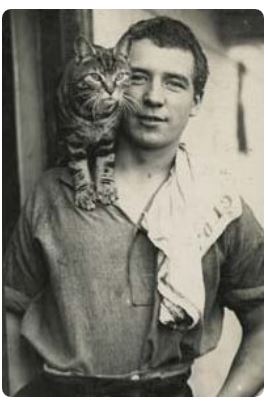
This is not Lord Haggis and Sammy McLean–it’s Mrs. Chippy and Perce Blackborow on the Endurance in 1915–but it’s a great picture.
A while back, I wrote about a cat named Duffy McNab, who lost his life when he tried to jump from his ship to Pier 64 on the Hudson River. When Duffy fell into the river, Quartermaster Angus MacLean jumped into the water and tried to save him.
In the following story, I’ll tell you about a ship cat named Lord Haggis, who was the cat of Chief Steward Sammy McLean. Like Duffy, Lord Haggis was no doubt named after a chief of a Scottish clan. Although this story takes place 20 years after Duffy’s last jump, I have to wonder if Angus anglicized his name and is the very same cat-loving sailor…
Lord Haggis Gets Left Behind
When the SS Pastores passenger ship of the Colombia Steamship Company arrived at Pier 8 on the East River in Brooklyn on February 19, 1934, the crew was ecstatic and excited to tell the amazing tale of their ship’s mascot cat, Lord Haggis. Lord Haggis had served many years with the Pastores, which provided passenger service between New York and Haiti, Jamaica, Colombia, and Panama.
Lord Haggis was under the care of Chief Steward Sammy McLean, who named the female cat Lord as opposed to Lady so as to avoid any potential unrest among the superstitious crew members. Lord Haggis may have been a lady cat, but she was reportedly not very ladylike when it came to catching mice.

The SS Pastores was built in 1913 in Belfast, Ireland, for the United Fruit Company, an American corporation that traded in tropical fruit grown on Central and South American plantations. She was commissioned with the US Navy as a troop transport during World War I from 1918-1919 (when this photo was taken). The Colombia Steamship Company chartered the Pastores from the United Fruit Company in 1932 for passenger service until World War II.
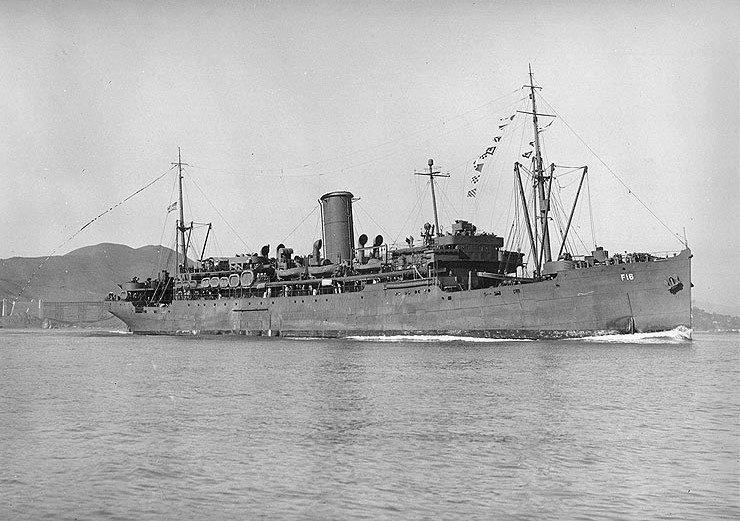
During Word War II, when this photo was taken, the Pastores was again placed in commission, this time as a provision ship for refrigerated and frozen foods. She was decommissioned in 1946 and sold for scrapping.
According to the crew of the Pastores, about a month prior to their arrival in Brooklyn, the ship had made an unscheduled stop in Port Morant, Jamaica, to pick up a cargo of bananas. Port Morant was about 39 miles south of the ship’s regularly scheduled passenger port in Kingston.
When the ship had been cleared, Lord Haggis was not at the muster. She was simply gone. The crew thought she had either fallen overboard or wandered ashore. I have a feeling her curiosity got the best of her and she decided to explore this new port while the cargo was being loaded.
The whole crew was both angry and upset that Lord Haggis had deserted the ship. The captain even crossed the cat’s name off the crew list, thinking she was gone for good.
The ship continued on to New York, and then returned south to Jamaica once more. When they arrived in Kingston on February 15 (about 4 weeks after the cat’s disappearance), they found Lord Haggis at the end of the dock. She was very thin, and her coat was raged and unkempt–she had lost some fur on her back–but she strode up the plank with her tail held high.
As she made her way up the gangplank with a shuffle in her gait, the crew on deck cheered lustily for their beloved lost mascot. The loyal ship’s cat had somehow traveled 39 miles from Port Morant to Kingston and was waiting for her crew to return and pick her up.
Officials of the Colombian Steamship Company told a reporter for The New York Times that the men would keep a close watch on Lord Haggis at ports. “Otherwise,” they explained, “it might become necessary for them to abandon her and get another mascot, one that would behave itself and not keep the company forever in the public prints.”
Pier 8 of the Old New York Dock Company
Up until July 1934, the Colombian Steamship Company ships docked at Pier 3 and Pier 8 of the New York Docks in the Cobble Hill section of Brooklyn. By August, the steamship line had moved to Pier 8 at Old Slip on the East River in Manhattan. J. P. Sutherland, passenger traffic manager for the Colombian Line, gave no reason for the move at the time, but many ships were leaving Brooklyn for Manhattan because of the better rail connections for passengers and cargo.
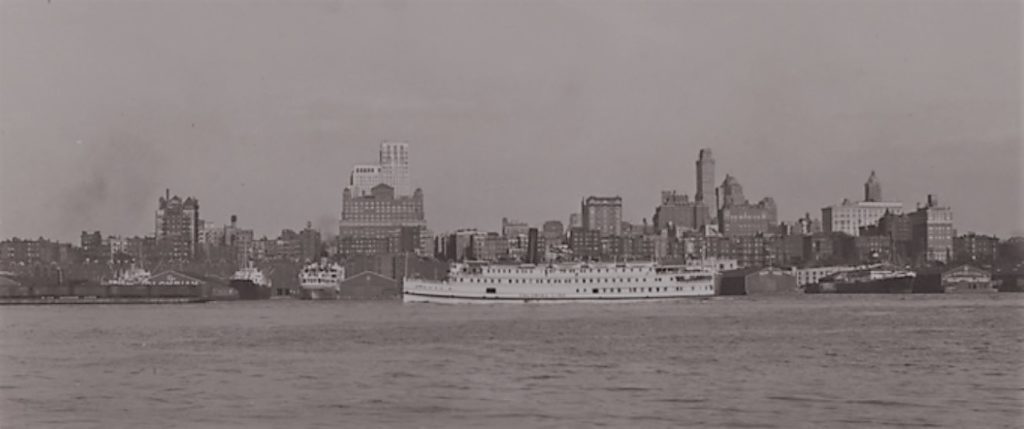
Here are Piers 3-8 (left to right) of the New York Docks in 1934, just before the Colombian Steamship line moved to Pier 8 at Old Slip on the East River in Lower Manhattan. It was here the sailors celebrated upon their return from Jamaica with Lord Haggis.
The New York Dock Company was organized in 1901, when acquired all of the property of the Brooklyn Wharf and Warehouse Company (organized in 1895). For the next 55 years, the company controlled a three-mile stretch of Brooklyn waterfront on the East River from the the foot of Main Street above the Brooklyn Bridge to Red Hook Point and the Erie Basin. Not only did the property include the piers and all fixtures, but it also included lands under water, warehouses, elevators, and numerous stores, including Empire, Watson, Harbeck, and Robert stores.
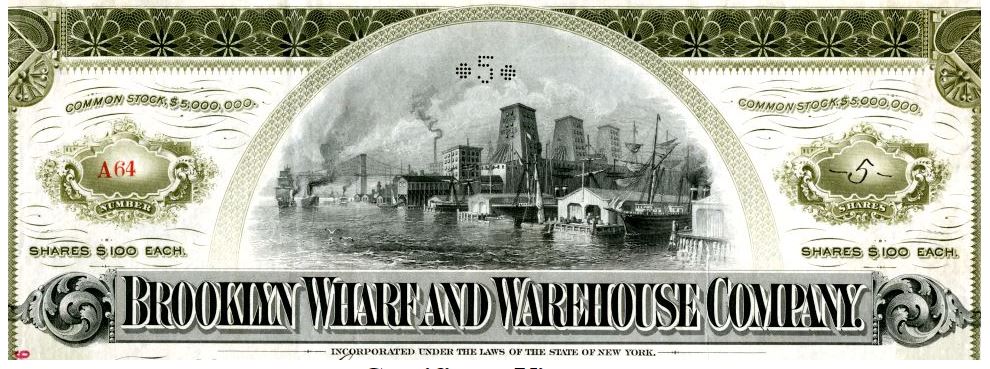
Sometime around 1956, the Port Authority of New York and New Jersey purchased two miles of Brooklyn waterfront from the New York Dock Company. This put in place an $85 million, seven-year development program–the greatest program of its kind ever undertaken in the New York-New Jersey Harbor–comprising the construction of 10 new piers, the rehabilitation of an existing pier, the construction of 3 new warehouses, and the improvement of 50 acres of upland area.
Under the Brooklyn-Port Authority marine terminal development plan, 25 of the existing obsolete piers, which were then from 36 to 65 years old, were replaced with 10 wide, single-story, steel and concrete structures fully fire resistant and fire protected. The plan replaced 44 narrow, deteriorated berths with 25 modern vessel berths, each with 90,000 square feet of shedded space and 20-foot aprons. Construction of the first new marine terminal, the $8 million Pier 11, a three-berth concrete platform in the Atlantic Basin, began on July 1, 1956, and was completed around April 1, 1958.
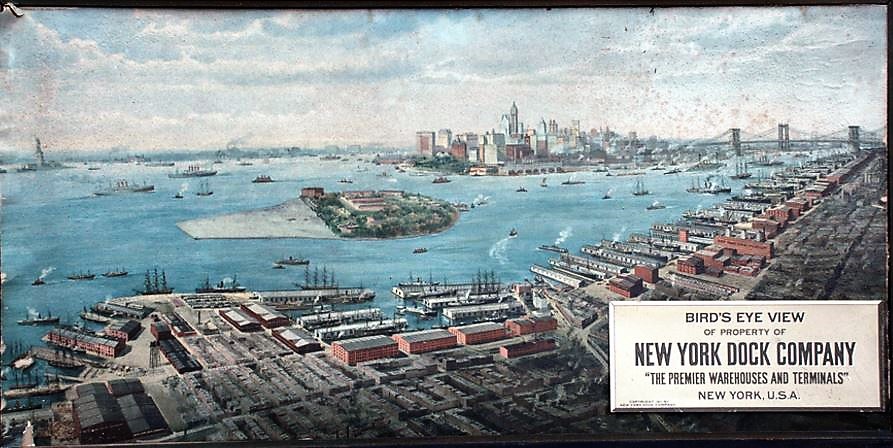
This colorized illustration of the New York Dock Company property is from The Pictorial History of Brooklyn, published by the Brooklyn Daily Eagle in 1916.

Here’s a section of the Brooklyn Port Authority Piers in 1959. Pier 8, where the SS Pastores docked and where the crew celebrated the return of Lord Haggis, was controlled by the Brooklyn Port Authority at this time. Museum of the City of New York Collections
In 1984, The Port Authority announced plans to close cargo operations and sell its piers for commercial development. Neighborhood-based grassroots groups immediately emerged to advocate for a new waterfront park, leading to the creation of the Brooklyn Bridge Park Coalition in 1989. The Brooklyn Bridge Park, which occupies the old Piers 1-6 of the New York Dock Company, officially opened in 2008.
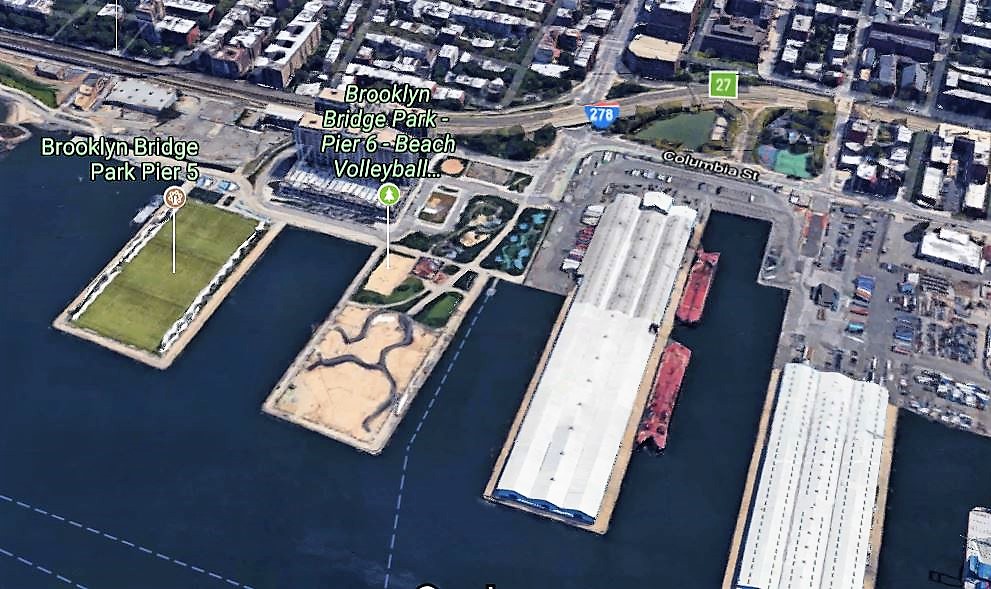
Today, the Old Pier 8, where sailors once celebrated the return of a ship’s cat named Lord Haggis, is today part of the Red Hook Terminal and the home of the MTC Trucking Company (far right). Maybe some day it will become part of the Brooklyn Bridge Park, and a memorial to Lord Haggis will be erected on the site…




..Hmm, would’ve enjoyed hearing more about Lord Haggis, and “why” she had disappeared, and what exactly had occured..(??) It is also interesting to hear about a place so different and removed from the place I am from.., that being the “west”.., I am, however, very intrigued with the east, having never been there. It is quite fascinating to me. I enjoy these stories and articles.., although many of them seem rather sad.., maybe its just me. I have always had cats throughout my life.., some dogs as well, but mostly cats. The relationship between a cat and a ships company/crew is a very interesting premise. Strikes me as a very necessary and even symbiotic relationship. ..I am very curious about the individual behind these accounts/articles.., for is this not truly a labor of love..(?!!) Thank you for your dedication..! ~Peace
I am so glad that you enjoy these stories, even though, yes, at times, they are very sad. I LOVE researching and writing these stories, so yes, it’s a labor of love. I work full-time as a medical writer, so there’s nothing I enjoy more than writing about a topic I love after I’ve spent a long day at the office writing about prescription drugs! You can learn more about me by going to the About page on my site. I’m hoping to compile the cat stories into a book — working on that right now, so stay tuned.
Hello ! I will definitely stay tuned, Thank You ! Sooo Kind of you to take the time to respond so warmly. Looking forward to more of your fascinating, & heartfelt postings. Good Luck !
~Peace, Rho~